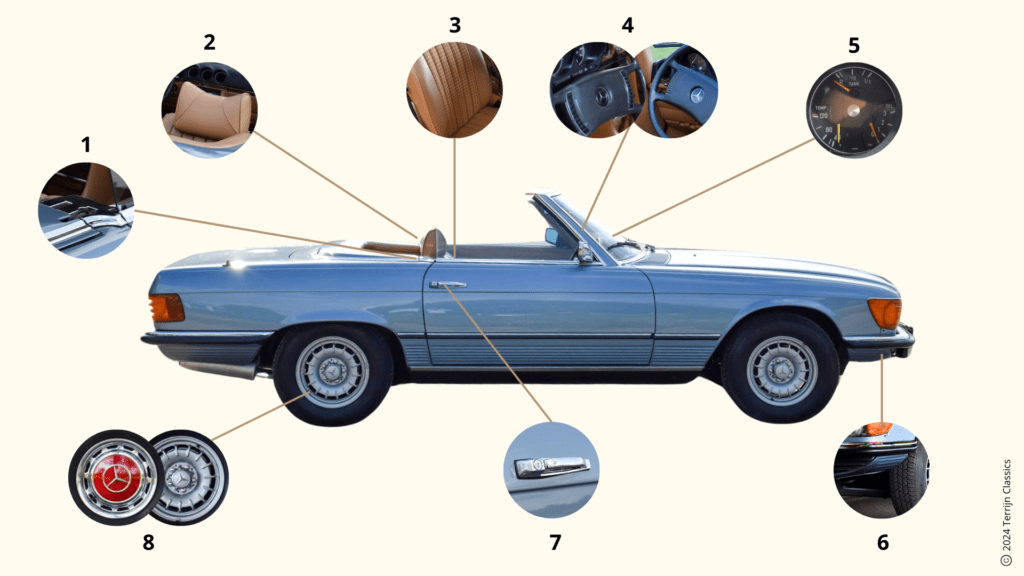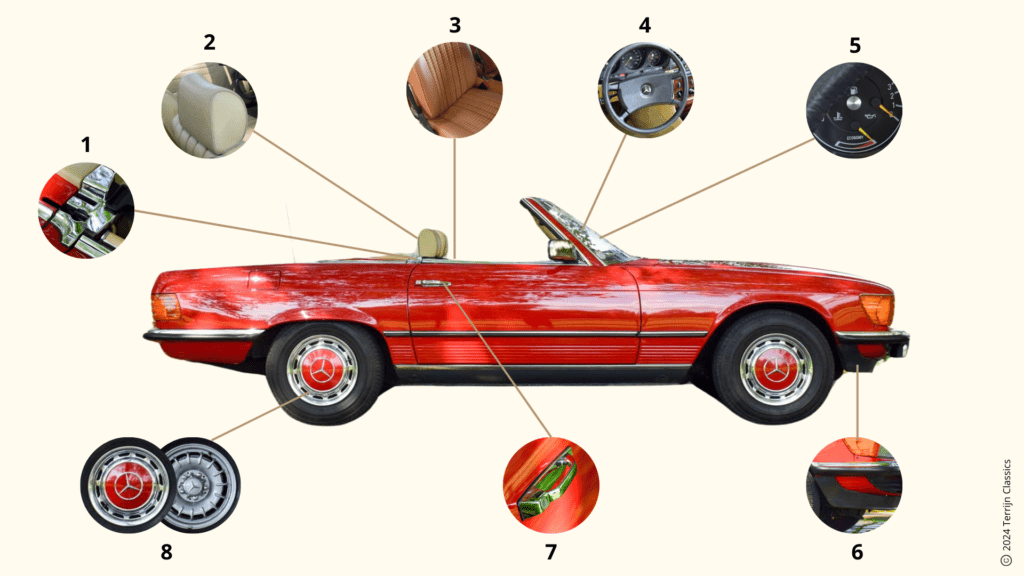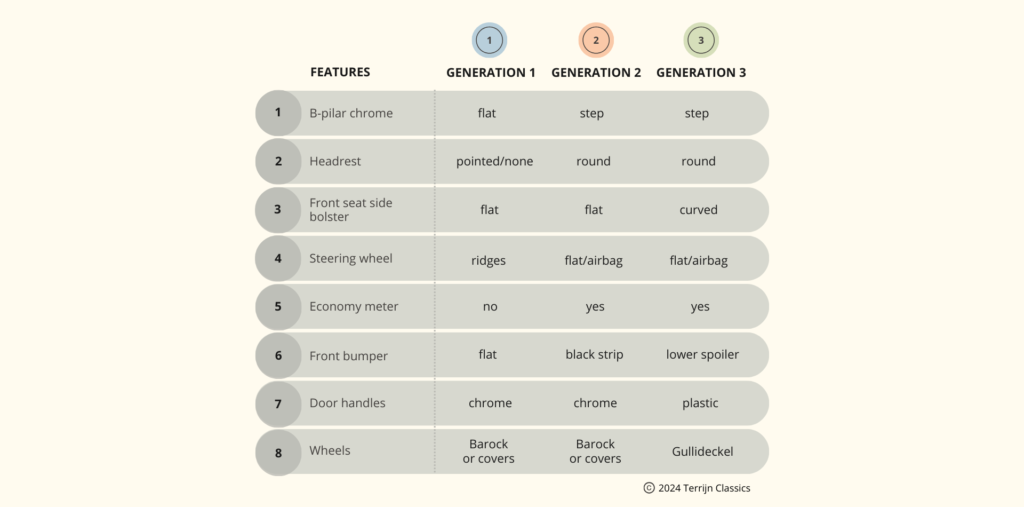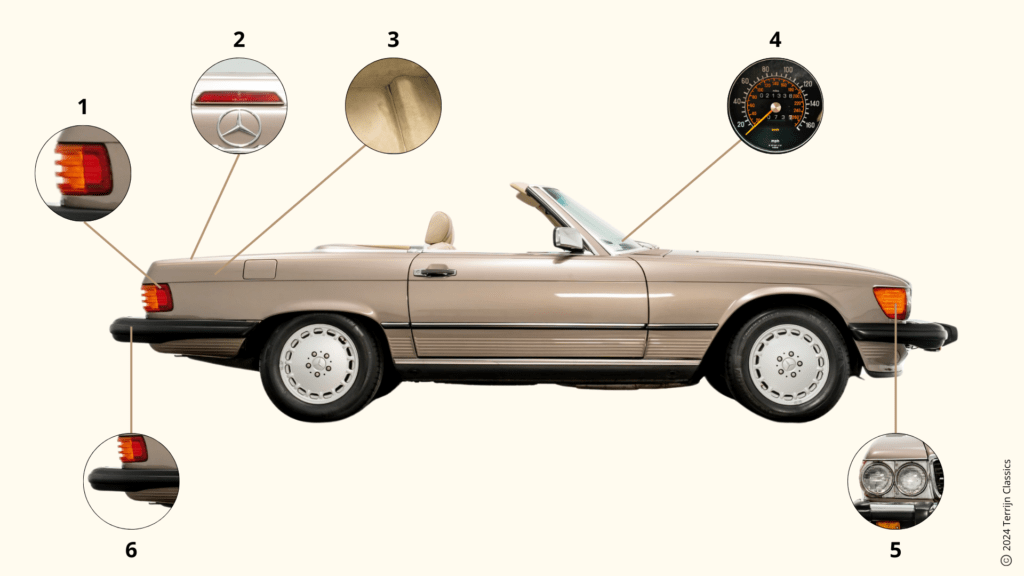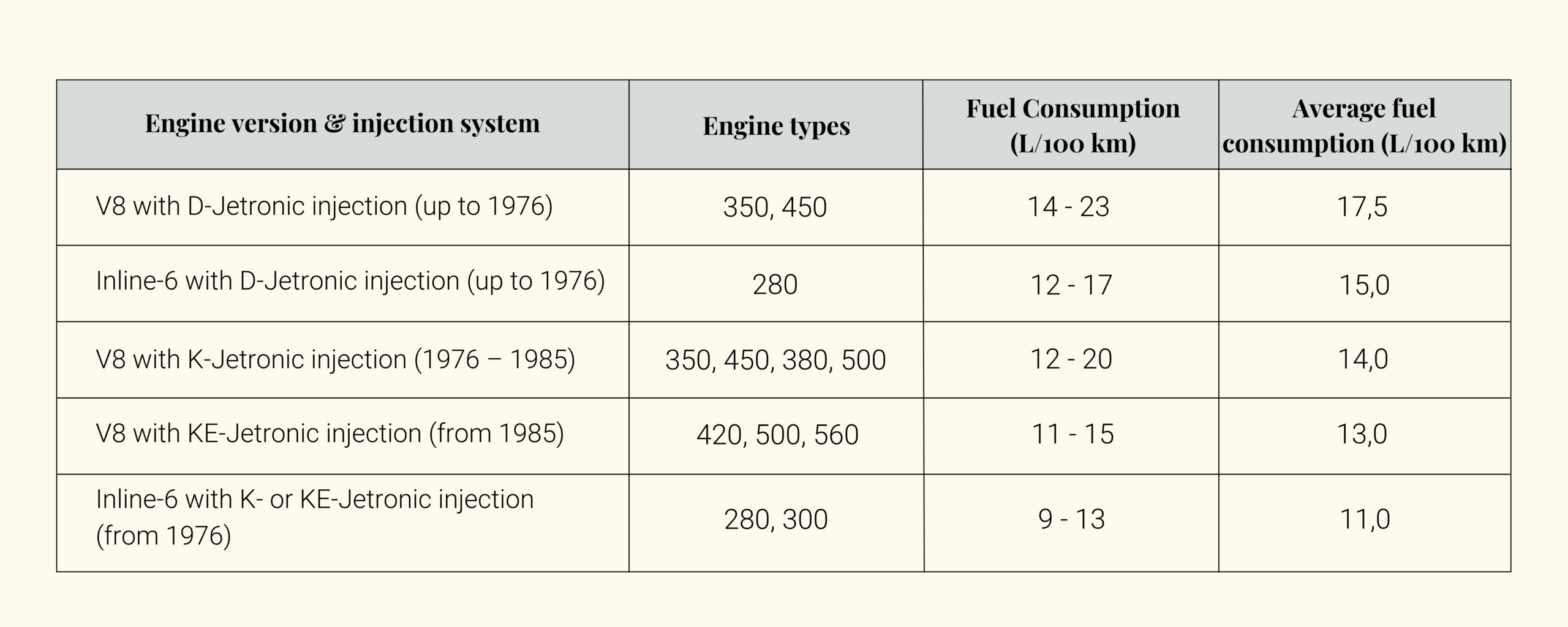Mercedes-Benz SL R107: model overview
The Mercedes-Benz R107 is the SL generation from the 1970s and 1980s. They are renowned worldwide for their versatility, reliability, and pleasant driving experience. The earliest models have been on the road for over 50 years, while the youngest are 35 years old or more, making them true classics. However, buying an R107 may raise some questions. What are the differences between the generations? What unique features do they have? What are the pros and cons? What should you look for when purchasing?
On this page, you will find comprehensive information about all R107 models, including their differences.
- An overview of generations and variants
- Physical characteristics by generation
- The pros and cons of each generation
- Realistic budgeting from a practical perspective
- Frequently asked questions about the model
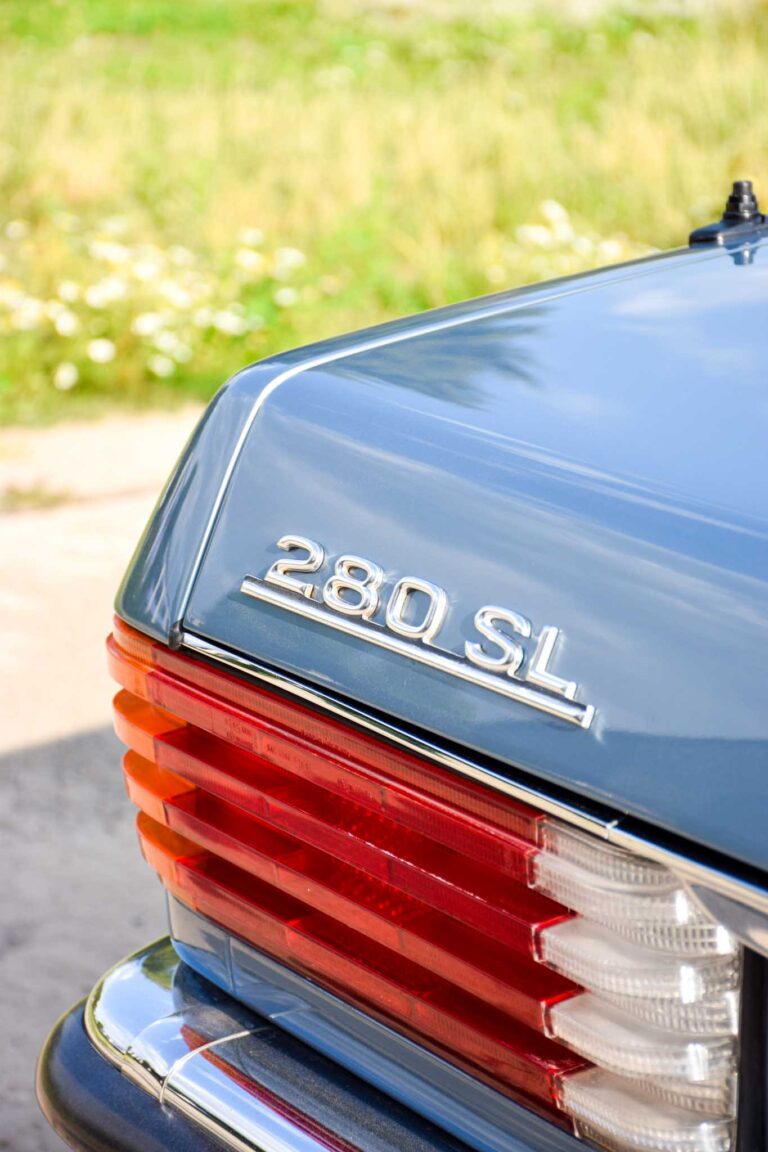
An overview of the three generations
The Mercedes R107 was produced in three generations, each with its own unique features and engine options. In the chart below, we have outlined these generations clearly. You will find details on the transmission and various engine options, from the 280 SL to the 560 SL. The differences between “European” and American versions are also covered.
* BHP stands for “Brake Horsepower” and is a measure of an engine’s power. It is a standard unit used to measure the engine’s strength before any losses from accessories like the alternator, water pump, or other drivetrain components are deducted.
The features per generation
Below, you will find the unique identifying features, as well as the strengths and weaknesses of the different models. Additionally, we provide a guideline for the expected budget based on the condition of the vehicle.
Generation 1: (1971 - 1980) 280 SL, 350 SL, 450 SL
Identifying features
- Chrome B-pillar trim
- Pointed headrests or no headrests on very early versions
- Seats with flat backrests in the front
- Old steering wheel types – ridges on the left and right
- No economy meter
- Flat front bumper
- Chrome door handles
- 14-inch alloy “Barock” wheels or steel wheels with covers
Fuel Injection: Bosch D-Jetronic until 1976, followed by Bosch K-Jetronic
Strenghts
- Greatest classic car feel and driving engagement
- Generally the lowest purchase prices
- Most classic design and look
Weaknesses
- Most susceptible to rust
- Harder to find a good example
- Higher fuel consumption
Realistic budget to expect
- Junk or major project €3.000 – €12.000
- Running but needing a lot of work €15.000 – €25.000
- Good with room for improvement €25.000 – €40.000
- Very good to perfect condition €40.000 – €75.000
Generation 2: (1980 - 1985) 280 SL, 380 SL, 500 SL
Identifying features
- B-pillar chrome with step
- Round headrests
- Seats with flat backrests in the front
- Flat steering wheel or steering wheel with airbag (rare)
- Economy meter
- Black strip below the front bumper
- Chrome door handles
- 14-inch alloy ‘Barock’ wheels or steel wheels with covers
Fuel injection: Bosch KA-Jetronic
Strengths
- Combines the best of both worlds
- Most reliable engines
- Significant improvements over the first models
Weaknesses
- Few high-quality V8 versions produced
- Less power compared to the third generation
Realistic budget to expect
- Junk or major project €4.000 – €15.000
- Running but needing a lot of work €15.000 – €30.000
- Good with room for improvement €30.000 – €45.000
- Very good to perfect condition €45.000 – €85.000
Generation 3: (1985 -1989) 300 SL, 420 SL, 500 SL, 560 SL
Strenghts
- Highest build quality and finish
- Nearly modern driving comfort
- Highest power outputs and most options
Weaknesses
- Highest purchase prices
- More complex due to additional systems and early electronics
- Less classic appearance
Realistic budget to expect
- Junk or major project €5.000 – €15.000
- Running but needing a lot of work €15.000 – €35.000
- Good with room for improvement €35.000 – €50.000
- Very good to perfect condition €50.000 – €95.000
How to identify a USA version of the R107?
There are only three engine variants that were factory-supplied to the USA: the 450 SL, 380 SL, and 560 SL. If you come across a different engine type with a USA registration or the large USA bumpers, it is not original. At that time, there was a ‘grey market’ where, for example, a 280 SL or 500 SL was exported to the USA after its delivery in Europe. This mainly occurred because those models were not officially available for sale there. In some states, owners could retain the original bumpers, while in others, mandatory modifications were made to comply with local regulations. As a result, you might sometimes see a 280 SL with the large USA bumpers.
In our workshop, we regularly perform the visual conversion of a USA version to the ‘European’ version. This usually includes the headlights, bumpers, taillights, third brake light on the trunk, and the speedometer. This transforms the vehicles into the more sought-after and elegant version of the R107. A high-quality conversion is a significant investment but adds substantial value. A USA version is worth more after the conversion.
Permanent identifying features after a conversion are the battery in the trunk, the engine number, and the original attachment of the front bumper to the chassis.
Frequently asked questions about the Mercedes-Benz R107
When considering a Mercedes-Benz R107, many questions often arise. In this section, we address the most common queries about the R107 and provide tips to help you avoid a bad purchase. If you have additional questions, feel free to contact us. We’re here to help!
The significant variation in quality. The main factor in determining the value of a Mercedes-Benz R107 is the condition of the vehicle. If you want a car that is both aesthetically and technically in good shape, it is always a better financial choice in the long run to opt for one in the best condition. The costs of quality restoration for these cars can quickly add up. In our workshop, we often see projects requiring repairs that exceed the purchase price. Often, the owner has made a common mistake by choosing a poorly maintained example due to its lower purchase price.
Differences between generations and models. Throughout the long production period, there were three generations of the R107 produced, each with different engine options. Within each generation, there are USA models that are generally worth less, partly due to their larger bumpers and lower power. A USA 380 SL with 155 hp is usually worth less than a European version of the 380 SL with 218 hp. Additionally, there is a significant difference in production numbers between the various models. A model with fewer units produced generally appreciates in value.
Which Mercedes-Benz SL R107 you should buy depends on your goals with the car. Are you looking for a lot of engine power? Comfortable and long drives? Or stylish cruising with a true classic feel? Additionally, your budget and long-term goals play a significant role. All models have their pros and cons, and any R107 can be a solid vehicle. The most important factor remains the overall condition of the car. You will get much more enjoyment from a less popular USA version of the 380 SL in excellent condition than from a sought-after third-generation 500 SL in poor condition.
Make sure you know what you’re doing. As with all major purchases and investments, when buying a classic Mercedes-Benz, it’s best to make a well-informed decision. Seek guidance or ensure that you are knowledgeable both technically and regarding the model. Looking for someone to assist with your purchase? Read here how we can help with professional buying advice.
Consider a budget for repairs after purchase. From practical experience, we know that almost every Mercedes R107 for sale will need overdue maintenance and repairs. If you allocate the entire budget to the purchase price, you are guaranteed to face unexpected costs later on. The solution? Allocate a budget for repairs when making the purchase.
Buy the right R107 for your goals. Do you want a perfect car with minimal or no issues? Then don’t settle for a vehicle that is worn out and unattractive. Restoration will almost certainly end up costing more than buying a well-maintained car that only needs minor repairs. If the appearance is less important to you but you want to enjoy worry-free long drives, allocate more budget for technical repairs, possibly with less focus on aesthetics.
As a Mercedes R107 specialist, we have clients who drive their cars almost daily or weekly. We also have clients who travel with their R107 three times a year but don’t drive much otherwise. Additionally, there are people who only drive in nice weather and want to keep their car in perfect condition. Every driver has different goals and habits, what matters most is considering your own goals when purchasing your Mercedes.
All-round and versatile
The biggest advantage of the Mercedes-Benz R107 is its versatility. It’s a car that’s enjoyable to drive sporty in the mountains, but also pleasant and comfortable for cruising. Since they still feel modern, there’s no barrier to using this car for a quick trip to the bakery on Sunday. Additionally, you can drive comfortably and without issues to the south of France.Value-retaining with significant potential
The prices of the R107 increase every year. There are no risky spikes that double in value within a year only to drop again, but rather a stable and reliable growth. Over the last five years, we have seen an increase of around €2,500 per year. These cars are currently still undervalued. Expectations are that the value of these models will rise significantly.Reliable and high build quality
Technically sound R107 models can take a beating. A Mercedes-Benz from this era is generally very solid and built to withstand a lot. Cars that are technically sound can be used without problems for a long trip to the south.Safe and suitable for today’s traffic
German safety engineering was a key feature in the 1970s and 1980s. Since the R107 SL belongs to a luxury segment, it represents some of the best Mercedes-Benz had to offer at the time. They come standard with technology that is still relevant and the norm. A Mercedes 107 features four disc brakes as standard, providing very good braking power. Models from 1980 onward offer optional ABS, which became standard on all models from 1986. From 1982, a driver’s airbag was also available as an option. Many cars also feature electric windows, central locking, air conditioning, heated mirrors, and more. Each R107 also has built-in crumple zones and safety standards that were ahead of their time, making you safer in an accident compared to many modern smaller cars.
Owning a Mercedes SL R107 comes with both fixed and variable costs.Thanks to the steady appreciation in value of this model, many owners manage to break even over time, or even make a profit, specially when they keep the car for several years. Gaining a clear understanding of these costs upfront provides a realistic view of the financial implications of owning and maintaining an R107.
FIXED COSTS:
-
Insurance:
- Third-party liability (BA): Between €150,00 and €250,00 per year, depending on your personal profile and insurer.
-
Comprehensive coverage (Omnium): Starting at €500,00 per year, usually ranging up to 1.2% of the insured value. The premium varies depending on the policy conditions and the insurer and typically becomes variable above an insured value of €50.000.
-
Road tax:
- Annual tax: Approx. €105,00 (flat rate, regardless of engine size or emissions).
- One-time registration fee: €55,00 (flat rate, regardless of engine size or emissions).
VARIABLE COSTS:
-
Maintenance & repairs:
- Well-maintained R107 in excellent condition: Costs are generally limited to regular maintenance and wear parts, averaging between €500,00 and €1.500,00 per year. This largely depends on mileage and vehicle usage.
- Average-condition car with age-related wear: Expect ongoing annual repairs and upgrades. Costs typically range from €500,00 to €5.000,00 per year.
- Catch-up maintenance: Often necessary shortly after purchase or following years of minimal upkeep. This includes accumulated repairs, overdue maintenance and non-functioning systems. Depending on the vehicle’s condition and how far you wish to go, such projects generally cost between €3.000,00 and €30.000,00. Be sure to check our list of common buyer mistakes to avoid unpleasant surprises.
- Unexpected costs: Major repairs like engine rebuilds or transmission failures can have a significant financial impact. We always inform our clients of this possibility in advance. At the same time, these investments often add value to the car by gradually restoring and technically upgrading it.
-
Fuel consumption:
Fuel consumption for a well-tuned classic like the Mercedes SL R107 or SLC C107 largely depends on the engine type. The table below provides real-world examples for various engine variants.
-
Transmission: Automatic gearboxes generally consume slightly more than manual transmissions.
-
Driving style and the type of journey (short city trips vs. longer drives) have the most significant influence on fuel consumption. Clients who mainly use the car for short urban trips average around 20 L/100 km, whereas those who take it on longer, more leisurely drives often report averages between 12 and 13 L/100 km.
-
Even though the higher fuel consumption might seem like a big deal, it’s usually not a major cost, especially if you don’t drive the car often. In reality, the extra cost is often less than people expect.
-
The Mercedes-Benz R107 SL is known for its reliability and everyday usability. It’s modern enough for longer journeys and semi-regular use, while still offering the classic look and feel of a true vintage car. For many, this makes it the ideal driver’s car and a perfect first classic.
If a R107 SL or SLC is in good technical condition, it’s perfectly suited for road trips of several thousand kilometres, without worry. However, preventive maintenance and timely repairs are key to avoiding breakdowns and ensuring peace of mind. We’ve compiled the most common causes of breakdowns we encounter in practice here: Mercedes R107 issues.
At Terrijn Classics, we’ve developed a Health Check for exactly this purpose: a preventive, systematic inspection of all key systems in the vehicle. You’ll find more information on the following page: Health Check .
Parts are generally well available for all versions. Most wear-and-tear components can still be sourced new and in solid quality, sometimes directly from Mercedes-Benz, sometimes through reliable aftermarket suppliers. If that proves difficult, there’s often a lower-quality aftermarket alternative available, though we only recommend this when no better option is available. For parts that are no longer produced, good-condition second-hand components are often still an option.
The classic Mercedes-Benz market is large and offers a wide range of available parts. These are premium vehicles with a higher value than the average classic car, which makes it worthwhile for manufacturers to invest in producing high-quality replacement parts. If you know where to look, the supply is both broad and dependable.
As specialists in classic Mercedes-Benz models, we know exactly where to source the right components. We always make a careful selection between original Mercedes-Benz (OEM) parts, high-quality aftermarket options, and when necessary well-sourced second-hand parts.
The Mercedes-Benz 107 SLC has seen a strong rise in popularity in recent years. It’s the closed coupé version of the R107 and is technically almost identical to the R107. Much of the information on this page therefore also applies to the SLC.
The main differences between the convertible and the coupé are found behind the A-pillar. The SLC features different front seats, a full-size rear bench and a longer wheelbase. This is clearly visible in the extended bodywork between the doors and the rear wheels. Instead of a soft top, the SLC has a fixed roof, often with an optional sunroof. The boot lid also has a different shape due to the altered roofline.
The Mercedes C107 or SLC belongs to the S-Class Coupé segment of the 1970s. It was a true luxury vehicle, positioned in the highest price range of its time. The 450 SLC 5.0 and 500 SLC versions also have a successful rally history.
A dedicated page about this model will be available soon to keep everything clear and well-organised. In the meantime, feel free to contact us if you have any questions.
A hardtop can enhance the driving experience of a Mercedes-Benz R107, depending on how and when you plan to use the car. For those who enjoy driving early in the spring or late into autumn, a hardtop offers extra comfort, especially in terms of warmth and sound insulation. During these in-between seasons, open-top driving is often less enjoyable, making the hardtop a practical solution.
It’s also a valuable option for owners who regularly drive long distances with their classic, for example to a second home. On the motorway, the hardtop significantly reduces wind noise at higher speeds. Once you arrive at your destination, the hardtop can be easily removed and stored, allowing you to enjoy open-top driving for the rest of your stay.
While not essential, the hardtop is a valuable addition for many owners. Some use it regularly, while others prefer to leave it aside due to the storage space it requires in the garage.


